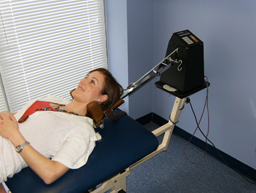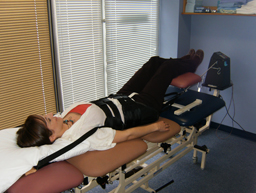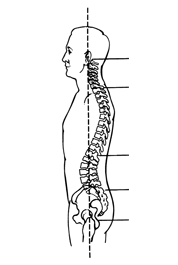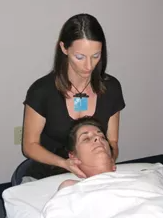What is spinal decompression or traction?
Spinal decompression or traction essentially means the same thing. Traction is the force applied and spinal decompression is the result of that force. It has been used in one form or another for centuries. There are paintings and statues from ancient civilizations showing healing practitioners using their hands to apply traction and help people in pain. Traction can be performed either by hand or using a mechanical traction unit. Unfortunately, many people historically associate traction with a torture device. It should not be confused with that as obviously traction has a positive purpose to help and not harm. Traction either by hand or by a mechanical unit has been used commonly by physiotherapists since the 1940’s.
A traction unit can be used for the neck and upper back as shown in the photo below or for the low back (lumbar spine) in the next photo below.


Traction is a gentle or moderate force that is applied to the spine for the purpose of slightly separating the bones or vertebrae of the spine. The best way to visualize this force to the low back is to imagine yourself hanging by your arms from an overhead bar and letting your legs and lower body relax and pulled by gravity. Or in the case of the neck, if you could hang upside down by your feet, a traction force would be applied to the neck. Of course this is not practical, especially if you are in pain, so that’s where a physiotherapist’s hands or the traction unit are beneficial. This force causes the vertebrae to be slightly separated usually by millimeters. In the low back there are five vertebrae and in the neck there are seven.

The photo below shows neck traction applied by a therapist’s hands.

What are the effects?
When the traction force is applied and the space between the bones is increased the following can occur:
- There is less pressure within the spinal discs relieving pain and encouraging nutrition to the disc.
- A protrusion or bulge in the disc may be reduced by drawing or “sucking” the gel nucleus towards the centre of the disc

- The tunnels where the nerves exit the spine become larger and therefore allow the nerves to “breathe” and regain proper circulation and become “un-pinched”.
- Painful or arthritic spinal joints are stretched and decompressed from the effects of constant gravity and poor posture acting on the body.
- Muscles, tendons and ligaments are lengthened and stretched in ways that are impossible with exercises and day to day movements unless you are able to fully relax and hang from a bar!
- Proper circulation and nutrition to the spine is achieved by allowing a flushing of inflammatory chemicals and bringing oxygen and nutrition to the area. This encourages healing and reduces painful irritation of the nerves in the spine.
Who benefits from spinal decompression?
Traction or spinal decompression helps a large percentage of people with spinal conditions, but:
There are two very important facts that should be understood and are supported by the best reviews of all available research on this topic.
- All patients must be evaluated by licensed and qualified professionals in the healthcare field. This can be a doctor or a physiotherapist. They will determine if it is beneficial and safe. There is only a certain category of neck and back pain patients that will see good outcomes. This needs to be evaluated ahead of time. There is only a certain category of neck and back pain patients that will see good outcomes.
- Like any other treatment,traction treatment needs to be used in conjunction with other programs. If not, results may be disappointing. An overall program of treatment should include any (or all) of the following:
- Individualized exercises that are tailored to you. Whether postural exercises, flexibility work or strengthening, these exercises help improve the spine and how it works.
- Neck and back body mechanics education.
- Therapy that is hands-on and works to reduce pain.
- Different treatment modalities (ask one of our experts to learn more).
If the person is carefully selected for traction and the above factors are addressed then certainly the majority of those people will see the benefits.
Generally the following conditions are potentially improved:
- Neck and lower back pain, either recent or longstanding that is of a mechanical cause
- Sciatica (thigh and leg pain)
- Disc bulging or protrusion
- Nerve compression (pinched nerve)
- Arthritis of the spine
- Degenerative disc disease
- Stenosis of the spine (narrowed nerve tunnels)
How safe and comfortable is it?
It is very safe when used properly. The patient lies on their back for either neck or back traction. Please see the above photos. For neck traction the person lies with their neck cradled and their head resting on the unit. The side pieces are slowly moved inwards in order to cup and cradle the neck. The patient’s head is not locked into position and they can lift their head easily out of the cradle if they wish. The computerized traction unit is then programmed by the physiotherapist starting with a gentle amount of pull through the rope usually between 12 and 18lbs and can be progressed up to 30 lbs. As a reference the human head weighs between 16 and 22 lbs. The patient is given careful instructions and has a safety button they can press any time to stop the traction if they are uncomfortable. The time of treatment varies between 8 and 25 minutes.
Low back traction is set up using a harness around the torso and ribs and one around the hips. The traction unit rope is attached to a harness which is wrapped around the hips. The legs are usually resting on a platform that is height adjustable depending on the desired angle of pull. The rope then pulls through the harness and the hips which tractions the spine because the hips are attached to the spine with strong ligaments and joints. The traction forces used are higher than in the neck because the lower spine requires more force to cause decompression, usually starting at 30-40 lbs. The table separates and splits beneath the lower back as the traction pulls which gives a greater effect.
Occasionally there is some extra pain during traction which may be normal. This needs to be evaluated by the physiotherapist as it depends on the location of pain and the degree. When the treatment is over the pain typically subsides.
How long before you see results?
Usually within two sessions the physiotherapist will be able to tell whether traction is going to be beneficial. If there are signs of progress then usually an average of six to ten sessions is sufficient.
Traction treatment is often used as part of a successful physiotherapy program. It should be viewed as one of the many tools physiotherapists have to help people with neck and back problems move towards a painfree lifestyle. The physiotherapists at Corydon Physiotherapy welcome any further questions on traction treatment.